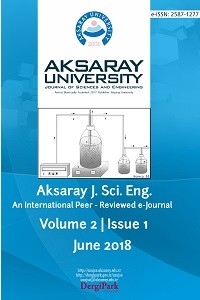Optimization of Combined Ozone/Fenton Process on Olive Mill Wastewater Treatment
Abstract
The aim of this study was to
investigate the applicability of Fenton process and combined ozone/Fenton
process to remove color, soluble chemical oxygen demand (CODs),
phenol, and dissolved organic carbon (DOC) from real olive mill wastewater
(OMW). The treatability of OMW was investigated in three different study parts.
Initially, Fenton process was optimized under varying H2O2/Fe2+
molar ratios ranging between 10 and 20 at the constant H2O2
concentration of 0.5 mM. The H2O2/Fe2+ molar
ratio of 10 was found optimum providing high color (51.6 %), CODs
(58%), DOC (27.9%) and phenol removals (93.9%). Further, combined ozone/Fenton
process was applied under gradually increasing dosages of Fe2+ and H2O2
reagents at constant H2O2/Fe2+ molar ratio of
10. The high color removal efficiency (51.6% color removal for Pt-Co) was obtained at the H2O2
and Fe2+ molar ratio of 0.5/0.05. Additionally, CODs,
color, DOC and phenol removal efficiencies improved at increasing reagents
concentrations. However, the color removal efficiency was adversely affected
while no significant difference on CODs and phenol removal was
observed at higher concentrations of molar concentrations above 0.5/0.05.
Additionally, the results indicated that combined process enhanced treatment
performance of OMW by 21%, 49% and 22% in terms of color, DOC and CODs
removals, respectively, compared to only-Fenton process. In the rest of this
study, combined ozone/Fenton process was optimized under varying ozonation time
(60-120 min) at the optimum H2O2 and Fe2+molar
dosage of 0.5/0.05 obtained from previous parts. Ozonation time significantly
affected the treatment performance, and optimum the reaction time was
determined as 90 minute in terms of the high treatment productivity and low
operating cost resulted from minimum ozone consumption and short reaction time.
Keywords
COD removal Color removal Ozone/Fenton process Olive mill wastewater Phenol removal Phenol removal
References
- [1] B. K. Mert, T. Yonar, M.Y. Kiliç, K. Kestioğlu, Pretreatment studies on olive oil mill effluent using physicochemical, Fenton and Fenton-like oxidations processes. Journal of hazardous materials 174 (2010) 122-128.
- [2] S. Khoufi, F. Aloui, S. Sayadi, Treatment of olive oil mill wastewater by combined process electro-Fenton reaction and anaerobic digestion. Water Research 40 (2006) 2007-2016.
- [3] G. Boari, I. M. Mancini, Combined treatments of urban and olive mill effluents in Apulia. Water Science and Technology 22 (1990) 235-240.
- [4] N. Adhoum, L. Monser, Decolourization and removal of phenolic compounds from olive mill wastewater by electrocoagulation. Chemical Engineering and Processing: Process Intensification, 43(10) (2004) 1281-1287.
- [5] P. Paraskeva, E. Diamadopoulos, Technologies for olive mill wastewater (OMW) treatment: a review. Journal of Chemical Technology and Biotechnology 81(9) (2006) 1475-1485.
- [6] M. Achak, A. Hafidi,N. Ouazzani, S. Sayadi, L. Mandi, Low cost biosorbent “banana peel” for the removal of phenolic compounds from olive mill wastewater: Kinetic and equilibrium studies. Journal of Hazardous Materials, 166 (1) (2009) 117-125.
- [7] A. Ginos, T. Manios, D. Mantzavinos, Treatment of olive mill effluents by coagulation–flocculation–hydrogen peroxide oxidation and effect on phytotoxicity. Journal of Hazardous Materials 133 (1) (2006) 135-142.
- [8] E.O. Akdemir, A.Ozer, Investigation of two ultrafiltration membranes for treatment of olive oil mill wastewater. Desalination 249(2) (2009) 660-666.
- [9] A. Chiavola, G.Farabegoli,F. Antonetti, Biological treatment of olive mill wastewater in a sequencing batch reactor. Biochemical Engineering Journal 85 (2014) 71-78.
- [10] S.C. Santos, R.A. Boaventura, Treatment of a simulated textile wastewater in a sequencing batch reactor (SBR) with addition of a low-cost adsorbent. J. Hazard. Mater. 291 (2015) 74-82.
- [11] C. Özdemir, M.K. Öden, S. Şahinkaya, E. Kalipçi, Color removal from synthetic textile wastewater by sonofenton process. Clean–Soil, Air, Water, 39(1) (2011) 60-67.
- [12] M. Punzi, A. Anbalagan, R. A. Börner, B. M. Svensson, M. Jonstrup, B. Mattiasson, Degradation of a textile azo dye using biological treatment followed by photo-Fenton oxidation: evaluation of toxicity and microbial community structure, Chemical Engineering Journal, 270 (2015) 290-299.
- [13] A. Gunay, D. Karadag, Recent developments in the anaerobic digestion of olive mill effluents. Process Biochemistry 50 (11) (2015) 1893-1903.
- [14] S. S. Abu Amr, H. A. Aziz, New treatment of stabilized leachate by ozone/Fenton in the advanced oxidation process. Waste Manag. 32 (2012) 1693-1698.
- [15] A. Goi, Y. Veressinina, M. Trapido, Combination of ozonation and the Fenton processes for land fill leachate treatment: evaluation of treatment efficiency. Ozone Sci. Eng. 31 (2009) 28-36.
- [16] M. Li, Z. Zeng, Y. Li, M. Arowo, J. Chen, H. Meng, L. Shao, Treatment of amoxicillinby O3/Fentonprocess in a rotating packed bed. J. Environ. Manage., 150 (2015) 404-411.
- [17] Z. Zeng, H. Zou, X. Li, M. Arowo, B. Sun, J. Chen, G. Chu, L. Shao, Degradation of phenolbyozone in the presence of Fentonreagent in a rotatingpacked bed. Chem. Eng. J., 229 (2013) 404-411.
- [18] J. Beltran-Heredia, J. Torregrosa, J. Garcia, J. R. Domínguez, J. C. Tierno, Degradation of olive mill wastewater by the combination of Fenton's reagent and ozonation processes with an aerobic biological treatment. Water science and technology: a journal of the International Association on Water Pollution Research, 44 (2001) 103-108.
- [19] S. Gocer, B. O. Eskikaya, M. Kozak, A. Duyar, V. Akgul, D. Akman, K. Cirik, Optimization of acid cracking method for olive mill wastewater pre-treatment acid cracking method for olive mill wastewater. International Journal of Advances in Science Engineering and Technology 5(3) Spl. Issue-2 (2017) 1-4.
- [20] M.F. Sevimli, H.Z. Sarikaya, M. Yazgan, A new approach to determine the practical ozone dose for color removal from textile wastewater. Ozone: Science&Engineering 25 (2003) 137-143.
- [21] D. Hermosilla, M. Cortijo, M.C.P. Huang, Optimization the treatment of landfill leachate by conventional Fenton and photo-Fenton process. Sci. Total Environ. 407 (2009) 3473–3481.
- [22] P. Van Aken, N. Lambert, J. Degrève, S.Liers, J. Luyten, Comparison of different oxidation methods for recalcitrance removal of landfill leachate. Ozone Science & Engineering 33(4) (2011) 294-300.
- [23] M. Yalılı Kılıç, T.Yonar, K. Kestioğlu, Pilot-scale treatment of olive oil mill wastewater by physicochemical and advanced oxidation processes. Environmental technology 34(12) (2013) 1521-1531.
- [24] http://www.mevzuat.gov.tr/Metin.Aspx?MevzuatKod=7.5.7221&sourceXmlSearch=&MevzuatIliski=0, Water Pollution Control Regulation in Turkey, 2011.
Abstract
References
- [1] B. K. Mert, T. Yonar, M.Y. Kiliç, K. Kestioğlu, Pretreatment studies on olive oil mill effluent using physicochemical, Fenton and Fenton-like oxidations processes. Journal of hazardous materials 174 (2010) 122-128.
- [2] S. Khoufi, F. Aloui, S. Sayadi, Treatment of olive oil mill wastewater by combined process electro-Fenton reaction and anaerobic digestion. Water Research 40 (2006) 2007-2016.
- [3] G. Boari, I. M. Mancini, Combined treatments of urban and olive mill effluents in Apulia. Water Science and Technology 22 (1990) 235-240.
- [4] N. Adhoum, L. Monser, Decolourization and removal of phenolic compounds from olive mill wastewater by electrocoagulation. Chemical Engineering and Processing: Process Intensification, 43(10) (2004) 1281-1287.
- [5] P. Paraskeva, E. Diamadopoulos, Technologies for olive mill wastewater (OMW) treatment: a review. Journal of Chemical Technology and Biotechnology 81(9) (2006) 1475-1485.
- [6] M. Achak, A. Hafidi,N. Ouazzani, S. Sayadi, L. Mandi, Low cost biosorbent “banana peel” for the removal of phenolic compounds from olive mill wastewater: Kinetic and equilibrium studies. Journal of Hazardous Materials, 166 (1) (2009) 117-125.
- [7] A. Ginos, T. Manios, D. Mantzavinos, Treatment of olive mill effluents by coagulation–flocculation–hydrogen peroxide oxidation and effect on phytotoxicity. Journal of Hazardous Materials 133 (1) (2006) 135-142.
- [8] E.O. Akdemir, A.Ozer, Investigation of two ultrafiltration membranes for treatment of olive oil mill wastewater. Desalination 249(2) (2009) 660-666.
- [9] A. Chiavola, G.Farabegoli,F. Antonetti, Biological treatment of olive mill wastewater in a sequencing batch reactor. Biochemical Engineering Journal 85 (2014) 71-78.
- [10] S.C. Santos, R.A. Boaventura, Treatment of a simulated textile wastewater in a sequencing batch reactor (SBR) with addition of a low-cost adsorbent. J. Hazard. Mater. 291 (2015) 74-82.
- [11] C. Özdemir, M.K. Öden, S. Şahinkaya, E. Kalipçi, Color removal from synthetic textile wastewater by sonofenton process. Clean–Soil, Air, Water, 39(1) (2011) 60-67.
- [12] M. Punzi, A. Anbalagan, R. A. Börner, B. M. Svensson, M. Jonstrup, B. Mattiasson, Degradation of a textile azo dye using biological treatment followed by photo-Fenton oxidation: evaluation of toxicity and microbial community structure, Chemical Engineering Journal, 270 (2015) 290-299.
- [13] A. Gunay, D. Karadag, Recent developments in the anaerobic digestion of olive mill effluents. Process Biochemistry 50 (11) (2015) 1893-1903.
- [14] S. S. Abu Amr, H. A. Aziz, New treatment of stabilized leachate by ozone/Fenton in the advanced oxidation process. Waste Manag. 32 (2012) 1693-1698.
- [15] A. Goi, Y. Veressinina, M. Trapido, Combination of ozonation and the Fenton processes for land fill leachate treatment: evaluation of treatment efficiency. Ozone Sci. Eng. 31 (2009) 28-36.
- [16] M. Li, Z. Zeng, Y. Li, M. Arowo, J. Chen, H. Meng, L. Shao, Treatment of amoxicillinby O3/Fentonprocess in a rotating packed bed. J. Environ. Manage., 150 (2015) 404-411.
- [17] Z. Zeng, H. Zou, X. Li, M. Arowo, B. Sun, J. Chen, G. Chu, L. Shao, Degradation of phenolbyozone in the presence of Fentonreagent in a rotatingpacked bed. Chem. Eng. J., 229 (2013) 404-411.
- [18] J. Beltran-Heredia, J. Torregrosa, J. Garcia, J. R. Domínguez, J. C. Tierno, Degradation of olive mill wastewater by the combination of Fenton's reagent and ozonation processes with an aerobic biological treatment. Water science and technology: a journal of the International Association on Water Pollution Research, 44 (2001) 103-108.
- [19] S. Gocer, B. O. Eskikaya, M. Kozak, A. Duyar, V. Akgul, D. Akman, K. Cirik, Optimization of acid cracking method for olive mill wastewater pre-treatment acid cracking method for olive mill wastewater. International Journal of Advances in Science Engineering and Technology 5(3) Spl. Issue-2 (2017) 1-4.
- [20] M.F. Sevimli, H.Z. Sarikaya, M. Yazgan, A new approach to determine the practical ozone dose for color removal from textile wastewater. Ozone: Science&Engineering 25 (2003) 137-143.
- [21] D. Hermosilla, M. Cortijo, M.C.P. Huang, Optimization the treatment of landfill leachate by conventional Fenton and photo-Fenton process. Sci. Total Environ. 407 (2009) 3473–3481.
- [22] P. Van Aken, N. Lambert, J. Degrève, S.Liers, J. Luyten, Comparison of different oxidation methods for recalcitrance removal of landfill leachate. Ozone Science & Engineering 33(4) (2011) 294-300.
- [23] M. Yalılı Kılıç, T.Yonar, K. Kestioğlu, Pilot-scale treatment of olive oil mill wastewater by physicochemical and advanced oxidation processes. Environmental technology 34(12) (2013) 1521-1531.
- [24] http://www.mevzuat.gov.tr/Metin.Aspx?MevzuatKod=7.5.7221&sourceXmlSearch=&MevzuatIliski=0, Water Pollution Control Regulation in Turkey, 2011.
Details
| Primary Language | English |
|---|---|
| Subjects | Engineering |
| Journal Section | Research Article |
| Authors | |
| Publication Date | June 30, 2018 |
| Submission Date | August 24, 2017 |
| Acceptance Date | February 13, 2018 |
| Published in Issue | Year 2018 Volume: 2 Issue: 1 |
Cited By
Optimization of Combined Ozone/Fenton Process on Olive Mill Wastewater Treatment
Aksaray University Journal of Science and Engineering
https://doi.org/10.29002/asujse.336035
A comprehensive review of combined processes for olive mill wastewater treatments
Case Studies in Chemical and Environmental Engineering
https://doi.org/10.1016/j.cscee.2023.100493
Effects of extraction processes on the physicochemical characteristics and phenolic compound content of olive mill wastewater: a comparative study
Euro-Mediterranean Journal for Environmental Integration
https://doi.org/10.1007/s41207-024-00672-3
Investigation of synthesis and sonocatalytic performance of activated carbon-supported catalysis systems
Journal of Solid State Electrochemistry
https://doi.org/10.1007/s10008-024-06158-0
Optimization of the combined Fenton and ozonation processes for efficient COD removal in rubber wastewater treatment
Case Studies in Chemical and Environmental Engineering
https://doi.org/10.1016/j.cscee.2025.101185
Aksaray J. Sci. Eng. | e-ISSN: 2587-1277 | Period: Biannually | Founded: 2017 | Publisher: Aksaray University | https://asujse.aksaray.edu.tr
ASUJSE is indexing&Archiving in










